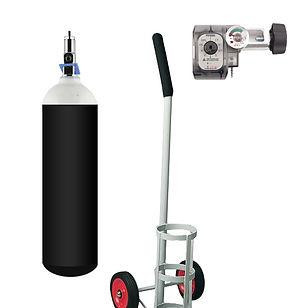Introduction:
Oxygen cylinders play a crucial role in providing life-saving support to individuals with respiratory conditions and those in need of supplemental oxygen. Understanding the price factors associated with oxygen cylinders is essential for patients, healthcare providers, and individuals seeking to ensure the availability of this vital resource. In this article, we will explore the factors that influence the cost of oxygen cylinders, shedding light on the pricing dynamics and helping you navigate this important aspect of medical care.
- Cylinder Size and Capacity:
The size and capacity of an oxygen cylinder significantly impact its price. Oxygen cylinders come in various sizes, ranging from small portable cylinders to large stationary ones. Larger cylinders with higher capacities can store and provide more oxygen, making them suitable for long-term use. As a general rule, larger cylinders tend to have a higher upfront cost compared to smaller ones due to the increased amount of oxygen they can hold.
- Type of Oxygen:
The type of oxygen used in cylinders can also influence the price. Medical oxygen, which is highly purified and meets specific safety standards, is typically more expensive than industrial or recreational oxygen. Medical oxygen undergoes rigorous quality control processes to ensure its safety and effectiveness for medical applications, which contributes to its higher cost.
- Refill vs. Disposable Cylinders:
There are two main types of oxygen cylinders: refillable and disposable. Refillable cylinders can be refilled with oxygen, either by using an oxygen concentrator or by visiting a refill center. Disposable cylinders, on the other hand, are meant for single use and are replaced entirely once the oxygen supply is depleted. Refillable cylinders generally have a higher upfront cost but can be more cost-effective in the long run, as they eliminate the need to purchase new cylinders repeatedly.
- Brand and Manufacturer:
The brand and manufacturer of the oxygen cylinder can also affect its price. Established and reputable brands that have invested in research, development, and quality control processes may have higher prices compared to lesser-known brands. It is important to prioritize safety and reliability when choosing an oxygen cylinder, ensuring that it meets necessary regulatory standards.
- Additional Accessories and Services:
The price of an oxygen cylinder may also include additional accessories or services. These can include regulators, flow meters, carrying cases, and oxygen masks or cannulas. Some suppliers may offer bundled packages that include these accessories, while others may charge separately for each item. It is advisable to consider the complete package and evaluate the value for money when comparing prices.
- Local Market Factors:
The pricing of oxygen cylinders can vary depending on local market factors, including supply and demand dynamics, geographical location, and competition among suppliers. Prices may fluctuate over time due to changes in raw material costs, transportation expenses, and other economic factors. It is advisable to research and compare prices from multiple suppliers to ensure you are getting the best value for your investment.
Conclusion:
Understanding the factors that influence the price of oxygen cylinders is crucial for individuals and healthcare providers seeking to ensure access to this life-saving resource. The size and capacity of the cylinder, the type of oxygen used, the refillability, the brand and manufacturer, additional accessories, and local market factors all contribute to the cost of an oxygen cylinder. By considering these factors and conducting thorough research, you can make informed decisions and choose an oxygen cylinder that meets your specific needs in terms of both functionality and affordability.
For More Info :-

No comments:
Post a Comment